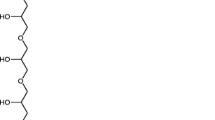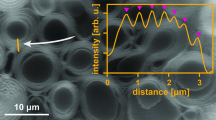Abstract.
This study revealed large distinctions between the lamellar and non-lamellar liquid crystalline lipid phases in their spreading at the air/water interface and propensity to form bilayer foam films. Comparative measurements were made for the lamellar Lα, the inverted hexagonal HII and the bicontinuous cubic Pn3m phases of the phospholipid dipalmitoleoylphosphatidylethanolamine (DPoPE). With regard to monolayer formation, followed as the decrease of surface tension with time, the best spreading (lowest surface tension) was observed for the Lα phase, and poorest spreading (highest surface tension) was recorded for the HII phase. The cubic Pn3m phase of DPoPE, induced by temperature cycling, retained an intermediate position between the Lα and HII phases. According to their ability to lower surface tension and disintegrate at the air/water interface, the three phases thus order as Lα>Pn3m>HII. Clearly expressed threshold (minimum) bulk lipid concentrations, C t, required for formation of stable foam bilayers from these phases, were determined and their values were found to correlate well with the bulk lipid phase behaviour. The C t values for Lα and HII substantially increase with the temperature. Their Arrhenius plots, lnC t versus 1/T, are linear and intersect at ~36–37 °C, coinciding with the onset of the bulk Lα→HII phase transition, as determined by differential scanning calorimetry. However, the C t value for the Pn3m phase, equal to 30 µg/mL, was found to be constant over the whole range investigated between 20 °C and 50 °C. The horizontal C t versus T plot for the Pn3m phase crosses the respective plot for the Lα phase at the temperature bounding from below the hysteretic loop of the Lα↔HII transition (~26 °C), thus providing a certain insight about the thermodynamic stability of the Pn3m phase relative to the Lα phase. The established strong effect of the particular lipid phase on the formation of monolayers and stable black foam films should be of importance in various in vitro and in vivo systems, where lipid structures are in contact with interfaces and disintegrate there to different extents.
Similar content being viewed by others
Author information
Authors and Affiliations
Additional information
Electronic Publication
Rights and permissions
About this article
Cite this article
Jordanova, A., Lalchev, Z. & Tenchov, B. Formation of monolayers and bilayer foam films from lamellar, inverted hexagonal and cubic lipid phases. Eur Biophys J 31, 626–632 (2003). https://doi.org/10.1007/s00249-002-0263-x
Received:
Accepted:
Issue Date:
DOI: https://doi.org/10.1007/s00249-002-0263-x




